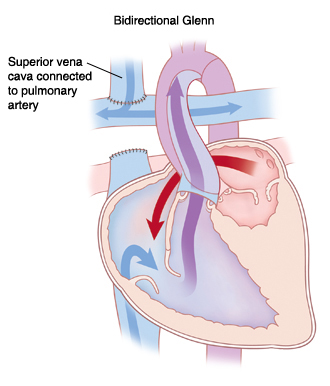Treatment for Your Child's Hypoplastic Ventricle: Stage II
Treatment for Your Child’s Hypoplastic Ventricle: Stage II
In hypoplastic left heart syndrome (HLHS), blood returning from the lungs must flow through an opening in the wall between the atria. The right ventricle pumps the blood into the pulmonary artery and blood reaches the aorta through a patent ductus arteriosus.
Your child has a heart problem that includes a hypoplastic ventricle. This means that one of the ventricles is either too small or is absent. The most common treatment for this problem is heart surgery. This is often done in 3 stages. This sheet explains what is done during the second stage (stage II). The surgery cannot repair your child’s heart problem. But it can help relieve your child’s symptoms. It may also increase your child’s chances of living a more normal life. The doctor can answer your questions and tell you more as needed.
In a normal heart, oxygen-poor blood is pumped to the lungs from the right ventricle. Oxygen-rich blood is pumped to the body from the left ventricle. |
The BDG procedure sends oxygen-poor blood returning from the upper body directly to the lungs. This helps decrease the workload of the single ventricle. |
The goals of heart surgery for a hypoplastic ventricle
Stage I. Make the single working ventricle the main pumping chamber of the heart, providing blood to both the lungs and the body.
Stage II. Decrease the workload of the single ventricle, and reduce the mixing of oxygen-poor and oxygen-rich blood.
Stage III. Separate the circulation of blood in the heart so that there is very little mixing of oxygen-rich and oxygen-poor blood.
What are the risks and complications?
Abnormal heart rhythm
Problems in the lungs
Infection
Bleeding
Problems with the nervous system, such as seizure of stroke
Abnormal buildup of fluid around the heart or lungs
Stage II: The bidirectional Glenn (BDG) procedure
The second stage of the surgery is called the BDG procedure. It is most often done when a child is 3 to 6 months old. A hospital stay of 5 to 7 days may be needed. The procedure provides low-pressure blood flow to the lungs. And it helps reduce the workload of the single ventricle. During the surgery, the surgeon:
Separates the superior vena cava (SVC) from the heart. The SVC is the large blood vessel that brings oxygen-poor blood from the upper body to the right atrium. This blood vessel is cut from the right atrium. The end closest to the right atrium is closed off. The other end is sewn to the right pulmonary artery. This allows oxygen-poor blood from the upper body to flow directly to the lungs, without passing through the heart. There, it receives oxygen.
Removes any additional source of blood flow to the pulmonary artery. If a shunt, band, or other device was placed during a previous procedure to direct blood to the lungs, it is removed at this time.
Fixes any other abnormal structures.
When to call your child's healthcare provider
Call your child's healthcare provider right away if any of these occur:
Increased redness, draining, swelling, or bleeding at the incision site
Increased swelling of the head and neck
Cyanosis
Fever 100.4°F (38°C) or higher
Trouble feeding, poor appetite, or poor weight gain
Irritability
Belly pain
Tiredness
Shortness of breath or trouble breathing
Cough that won’t go away
Nausea or vomiting that continues
Irregular heartbeat
No noticeable improvement
Updated:
August 17, 2018
Sources:
Hypoplastic Left Heart Syndrome, Up To Date
Reviewed By:
Ayden, Scott, MD,Bass, Pat F. III, MD, MPH,Image reviewed by StayWell medical illustration team.

